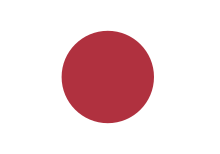
The Empire of Japan, also referred to as the Japanese Empire, Imperial Japan, or simply Japan, was the Japanese nation-state that existed from the Meiji Restoration in 1868 until the enactment of the reformed Constitution of Japan in 1947. From 29 August 1910 to 2 September 1945, the Empire of Japan included the naichi and the gaichi. It also ruled colonies such as Kwantung, South Seas, Mantetsu, and its concessions. In the closing stages of World War II, with Japan defeated alongside the rest of the Axis, the formalized Japanese Instrument of Surrender was issued in compliance with the Potsdam Declaration of the victorious Allies, and Japanese de facto territory subsequently shrunk to cover only the Japanese archipelago as it is today.

Bakumatsu was the final years of the Edo period when the Tokugawa shogunate ended. Between 1853 and 1867, under foreign diplomatic and military pressure, Japan ended its isolationist foreign policy known as sakoku and changed from a feudal Tokugawa shogunate to the modern empire of the Meiji government. The major ideological-political divide during this period was between the pro-imperial nationalists called ishin shishi and the shogunate forces, which included the elite shinsengumi swordsmen.

The Imperial Japanese Navy was the navy of the Empire of Japan from 1868 to 1945, when it was dissolved following Japan's surrender in World War II. The Japan Maritime Self-Defense Force (JMSDF) was formed between 1952 and 1954 after the dissolution of the IJN.
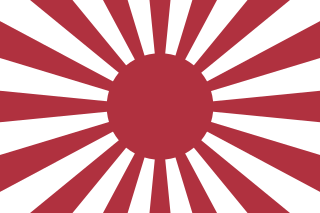
The Imperial Japanese Army (IJA) was the principal ground force of the Empire of Japan. Forming one of the military branches of the Imperial Japanese Armed Forces (IJAF), it was controlled by the Imperial Japanese Army General Staff Office and the Army Ministry, both of which were nominally subordinate to the Emperor of Japan, the supreme commander of IJAF. During the 20th century, an Inspectorate General of Aviation became the third agency with oversight of the IJA. At its height, the IJA was one of the most influential factions in the politics of Japan.
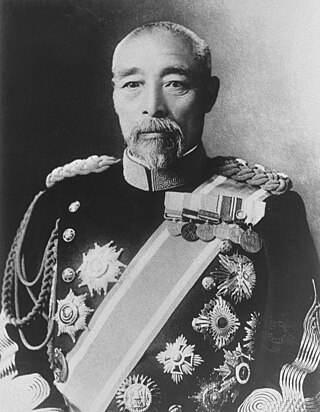
CountOku Yasukata was a Japanese field marshal and leading figure in the early Imperial Japanese Army.
This article is concerned with the events that preceded World War II in Asia.

Japanese militarism was the ideology in the Empire of Japan which advocated the belief that militarism should dominate the political and social life of the nation, and the belief that the strength of the military is equal to the strength of a nation. It was most prominent from the start of conscription after the Meiji Restoration until the Japanese defeat in World War II, roughly 1873 to 1945. Since then, pacifism has been enshrined in the postwar Constitution of Japan as one of its key tenets.
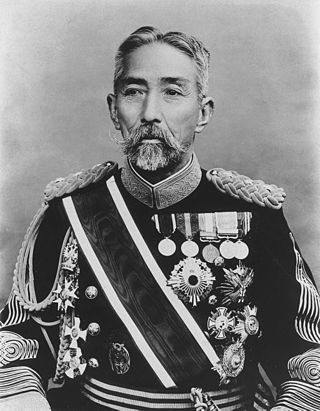
Field Marshal The Marquis Nozu Michitsura was a Japanese field marshal and leading figure in the early Imperial Japanese Army.

Marshal Admiral BaronIjūin Gorō was a Meiji-period career officer in the Imperial Japanese Navy.

CountKabayama Sukenori was a Japanese samurai military leader and statesman. He was a general in the Imperial Japanese Army and an admiral in the Imperial Japanese Navy. He later became the first Japanese Governor-General of Taiwan during the island's period as a Japanese colony. He is also sometimes referred to as Kabayama Motonori.

Baron Tatsumi Naofumi was a samurai from the Kuwana Domain in the Bakumatsu period Tokugawa shogunate and later a general in the Imperial Japanese Army during the Meiji period.
Below is the order of battle for the Battle of Beiping-Tianjin, called the Peiking-Tientsin Operation in pinyin spelling, a series of battles fought from 25 July through 31 July 1937 as part of the Second Sino-Japanese War. It was called the North China Incident by the Japanese.

ViscountTakashima Tomonosuke was a samurai of Satsuma Domain, general in the early Imperial Japanese Army, and a cabinet minister in Meiji period Japan. Part of Sophia University in Tokyo is located on the site of his house.
Military Medal of Honor was a military decoration for meritorious service to the Empire of Japan, formerly awarded to all military personnel who participated in battles in a war. These war medals and accompanying certificates specifically identify the conflict for which the decoration will have been awarded.

Viscount Ōshima Yoshimasa was a general in the early Imperial Japanese Army during the First Sino-Japanese War and the Russo-Japanese War. His great-great-grandson, Shinzō Abe was Prime Minister of Japan.

Ōdera Yasuzumi was a general in the early Imperial Japanese Army, and the highest ranking casualty on the Japanese side in the First Sino-Japanese War.
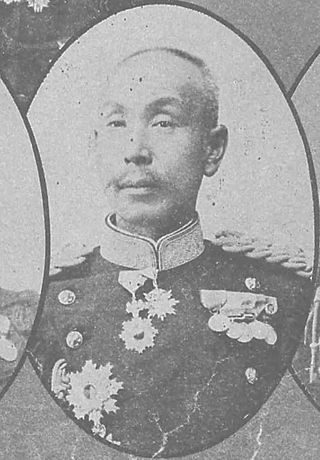
ViscountOgawa Mataji was a general in the early Imperial Japanese Army. He was also the father-in-law of Field Marshal Gen Sugiyama.

Viscount Nishi Kanjirō was a career soldier in the early Imperial Japanese Army, serving during the Russo-Japanese War.
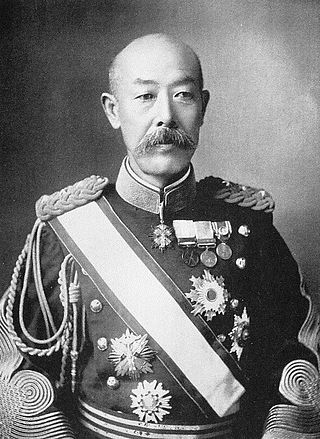
Baron Ueda Arisawa was a general in the early Imperial Japanese Army.
Japanese military currency (日本軍用手票) is the name given to money used by the Japanese armed forces for the purchase of supplies in occupied territories. It was mainly issued in denominations of yen, and subsidiary currency of sen with the exception of the first Sino-Japanese War series. This particular article covers pre-Shōwa era currency issued from 1894 to 1918 in three different periods. During this time Japan was militarily involved in the First Sino-Japanese War, Russo-Japanese War, and events during World War I such as the Siberian intervention. The military currency issued during these events circulated in Japanese Korea, the Republic of China (Manchuria), and the Russian State. All of the notes issued share a similar design which resembles government issued civilian currency which circulated in Japan from 1872 to 1899. Japanese military currency was exchangeable at the given time for both silver and gold bullion. Most of these events were not long term which impacted the amount of surviving currency in different ways. It was also routine after each event for officials to exchange the military currency issued for bullion or other forms of payment such as banknotes. Unredeemed notes were thus either held by the public as commemorates or eventually lost in the decades that followed. Those that remain today are collected and traded depending on the condition and surviving rate of the series.
